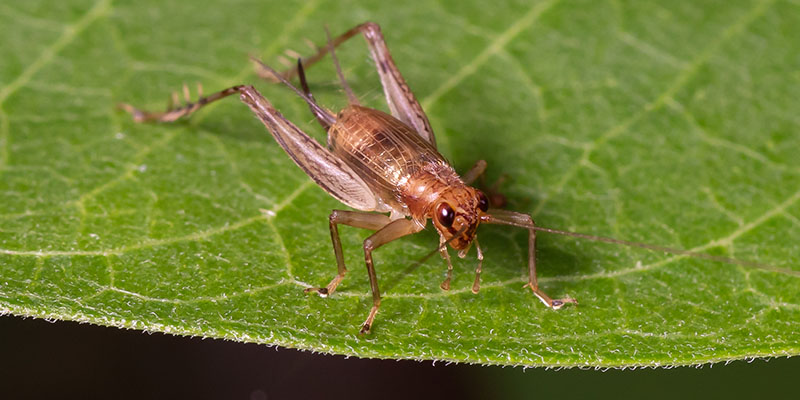Crickets: More Trouble Than Homeowners Think and How to Deal with Them When They Start Showing Up on Your Property
Crickets, while often associated with their cheerful chirping on warm summer nights, can become more than pleasant background noise—they can be a significant nuisance for homeowners and even morph into a very troublesome pest. Not only will they eat just about anything – clothing, boxes, books, et cetera – but the constant chirping, especially in a room that echoes, can drive a sound-sensitive person absolutely crazy.
In the following article, we will look at the most common cricket species in Arizona, the potential health risks they pose, the types of damage they can inflict on a home and its landscaping, their entry methods into residential spaces, detection techniques, preventive measures, and the crucial role of professional pest control in eradicating cricket infestations.
The Most Common Cricket Species in Arizona
In Arizona, two cricket species are particularly prevalent—the House Cricket and the Field Cricket. House Crickets are small, light brown insects that often invade homes, while Field Crickets are larger, darker, and primarily inhabit outdoor spaces.
House Cricket (Acheta domesticus)
The house cricket is one of the most widespread and easily recognizable cricket species in Arizona. These small, light brown crickets measure about 3/4 of an inch in length and have shorter antennae than other cricket species. They are often found in homes and attracted to warmth and light.
Tropical House Cricket (Gryllodes supplicans)
The tropical house cricket is similar in appearance to the house cricket, but it has a slightly shorter body and darker coloration. These crickets are also attracted to warm, humid environments and are often found in homes and businesses.
Field Cricket (Gryllus spp.)
Field crickets are larger than house crickets, typically measuring between 1 and 1.5 inches in length. They are usually black or brown in their coloring and have distinctive spurs on their jumping legs. Field crickets are most commonly found in outdoor environments, such as fields, meadows, and gardens.
Cave Cricket (Ceuthophilus spp.)
Cave crickets are also known as camel crickets or spider crickets. They are long-legged, wingless insects with a humped back, giving them a somewhat camel-like appearance. Cave crickets are typically found in moist, dark environments, such as caves, crawl spaces, and under porches.
Mole Cricket (Gryllotalpidae spp.)
Mole crickets are burrowing insects with strong, paddle-like front legs that they use to dig tunnels underground. They are usually colored brown or gray and have a hairy body. Mole crickets are most commonly found in moist soil, such as lawns, gardens, and agricultural fields.
These are just a few of the many cricket species that can be found in Arizona. With their diverse range of sizes, colors, and habitats, crickets play an important role in the state’s ecosystem.
Potential Health Risks
While crickets are not known to pose significant health risks to humans, their presence can trigger allergic reactions in some individuals. Additionally, their feces and body parts, if ingested, may cause mild gastrointestinal discomfort – gross!
Damage to a Home and Its Landscaping
Crickets can cause several types of damage, which can include but necessarily be limited to the following:
- Chewing damage. Crickets feed on a variety of materials, including fabric, paper, and organic matter, potentially damaging clothing, wallpaper, and garden plants.
- Structural damage. In some cases, crickets may nibble on wallpaper or fabric in the home, leading to unsightly holes and visible, aesthetic damage.
- Lawn and garden damage. Crickets can harm plants and grass by feeding on their roots, causing patches of dead or dying vegetation.
Entry into Residential Homes
Like many other pests, crickets can enter homes through a few different common means:
- Cracks and crevices. Small openings in walls, windows, and doors.
- Vents and pipes. They may use vents and pipes as entry points.
- Doors and windows. Crickets can easily crawl under doors or through gaps around windows.
Detecting Crickets in a Household
Identifying a cricket infestation involves doing these simple things:
- Listen for chirping sounds. Male crickets produce a distinctive chirping sound to attract females. This may be more noticeable at night.
- Conduct a visual inspection. Look for live crickets or their droppings in and around the house.
- Look for damaged items. Check for signs of chewing or feeding damage on fabrics, paper, and plants.
Preventive Measures
In order to keep crickets out of your home and off your property, you can take the following preventative measures:
- Sealing entry points. Use caulk to seal cracks, gaps, and openings in windows, doors, and walls.
- Outdoor lighting. Consider using yellow insect-resistant outdoor lights, as bright lights can attract crickets.
- Reduce moisture. Eliminate sources of standing water and reduce excess moisture in and around the home.
Professional Pest Control
When do-it-yourself, preventive measures fall short, professional pest control is essential. Pest control companies offer:
- Inspection. Comprehensive assessments to identify the extent of the infestation.
- Treatment plans. Tailored strategies using insecticides, traps, and other effective methods.
- Long-term solutions. Ongoing monitoring and preventive measures to ensure a cricket-free environment.
What It All Comes Down To
Crickets may seem harmless, but their potential to cause damage and nuisance should not be underestimated. Understanding their habits, implementing preventive measures, and seeking professional pest control assistance when needed are essential steps to keep cricket infestations at bay. By taking a proactive approach, homeowners can protect their properties from the unwanted presence of crickets and preserve the comfort and integrity of their living spaces.
